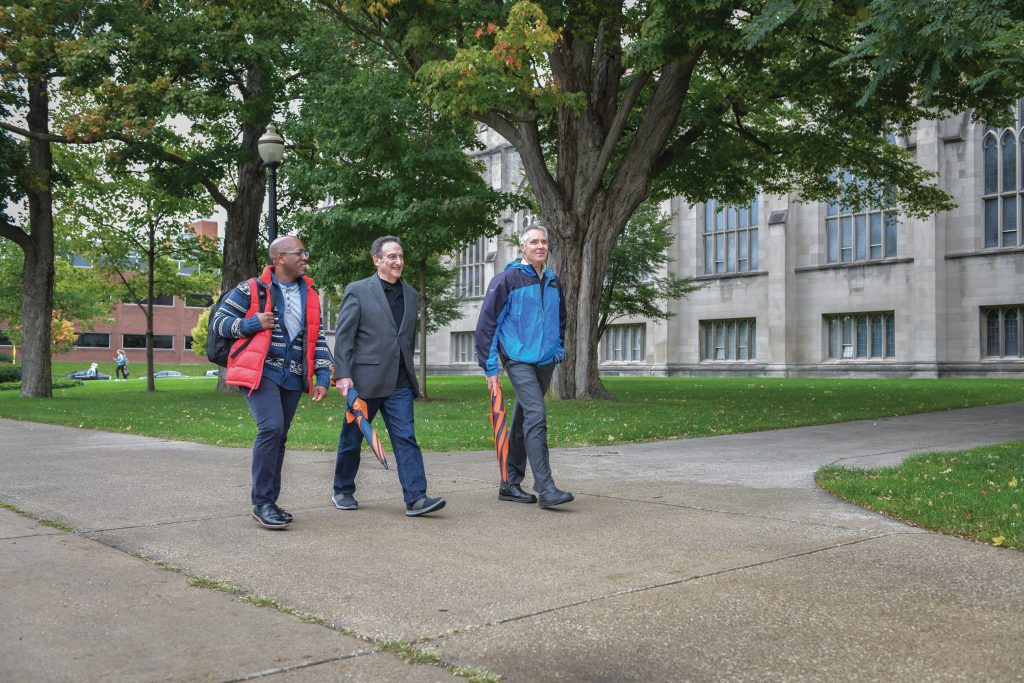Acclaimed NPR Science Friday host Ira Flatow has been sharing his enthusiasm for science with the public for more than 40 years, including previously on the Emmy-winning Newton’s Apple on PBS.
On Tuesday, Oct. 15, he addressed a likewise enthusiastic audience at Hope, presenting “Catalysts of Creation” to a crowd of hundreds — students, faculty and staff, retirees, school children and their parents, and other area residents — in the Concert Hall of the Jack H. Miller Center for Musical Arts through the college’s Gentile Interdisciplinary Lectureship in the natural and applied sciences.
Highlighting a mix of inventions and how they originated, Flatow explored commonalities running through the development, success and sometimes obscurity of each, including necessity, timing, inspiration, vision, determination, luck and even failure.
I want to emphasize that you don’t have to be a scientist to be an inventor… Everybody’s got some sort of creativity in them.
His examples also included professional scientists and gifted amateurs alike, which illustrated another central message. “I want to emphasize that you don’t have to be a scientist to be an inventor,” he said. “So the good news is that you don’t have to be this caricature of Einstein to be very creative. Everybody’s got some sort of creativity in them.”
A few of the many inventors and inventions that he discussed:
- Actress Hedy Lamarr, who he noted helped address a need during World War II by collaborating with musician George Antheil to protect the U.S. Navy’s torpedoes from radio interference. It’s technology, Flatow added, that continues to be relevant. “It was called frequency hopping and became the basis for modern Wi-Fi,” he said.
- The fuel cell, which Flatow observed was patented in 1839 but largely forgotten until the space race. “And so they rediscovered the fuel cell, because not only are hydrogen and oxygen [used in the fuel cells] lighter than a lead-acid battery, when you mix them together, you get a product that you absolutely desire to have [in space]: water,” he said.
- Thomas Edison, whose genius, Flatow said, involved more than his successful version of the incandescent bulb. “People knew how to make a light bulb; they couldn’t make one as good as he did,” Flatow said. “But he did something that none of the other light bulb makers accomplished. And that is, he created the whole distribution system.”
- The three young women who at age 16 won the 2014 Google Science Fair, for which Flatow was a judge. Observing in a family garden that a specific bacteria helped a plant grow, they wondered, Flatow said, if it might benefit other plants and thereby help address hunger by boosting crop yields. He noted that plant scientists with whom they consulted were discouraging, so they persisted and spent the next three years conducting their own experiments. “You know what? The plants were 75 percent more productive when they had those bacteria on their roots than when they didn’t,” he said.
- Silly Putty, which Flatow explained developed from a failed attempt at creating synthetic rubber to deal with shortages during World War II. “It only had one short problem,” he said. “It dissolved in water. Not good for tires.” It was reimagined by others as a toy, selling millions in the decades since. “It’s an idea that had nowhere to go, but somebody was smart enough to think about it,” he said.
In the background: Ira Flatow (center) tours campus with Associate Provost Dr. Gerald Griffin of the biology and psychology faculty (left) and Dr. Jonathan Peterson ’84, who is the Lavern ’39 and Betty DePree ’41 Van Kley Professor of Geology and Environmental Science (right).
